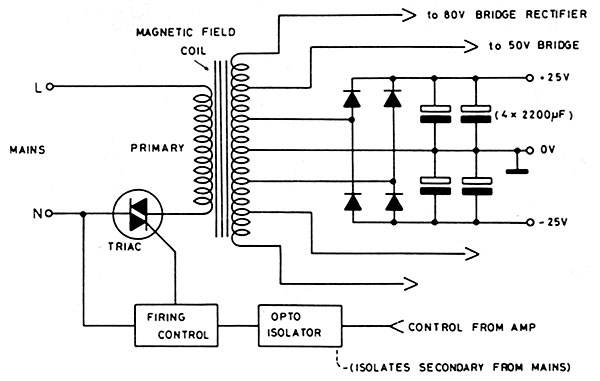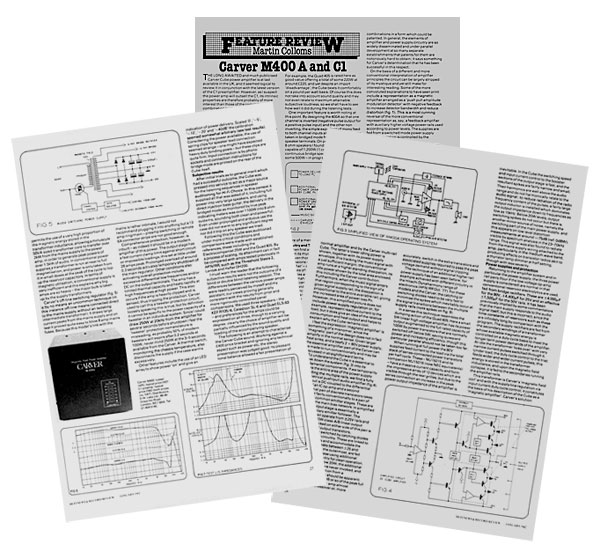Carver M-400 A Cube Page 2
This transformer is Carver's 'magnetic field coil' and with the supply line regulation via input current duty cycle control, it constitutes the basis of his description of the Cube as a 'magnetic amplifier'. Carver's solution permits the use of a very high proportion of the magnetic energy stored in the transformer inductance, allowing a minuscule 50VA sized transformer core to transfer over 2kW from the mains supply to the power amp, in order to generate peak powers of over 1.5kW of audio. In conventional power supplies a transformer is run at near to full magnetisation, and power is only taken from it in small doses at the peak of the cycle to top up the reservoir capacitors. In terms of magnetic utilisation, a conventional supply is very inefficient and this explains why big amps are so heavy – the major bulk is taken up by the supply transformers.
Carver's off-line switching regulator [see Fig 3] is by no means an uncommon technique (in this instance off-line means it is connected direct to the mains supply without an isolating intermediate transformer). lt draws large current peaks from the mains supply and on test it proved easy to blow 8A mains fuses. As this model's link with the mains is rather intimate, I would not recommend plugging it into anything other than a 13A ring/main. Preamp switching or remote 6A connector strips are simply not good enough.

Comprehensive protection, however, is inbuilt. The output stage has a fast current clamp limit against short-circuit or impossible loadings, this set at little under 28A peak. Prolonged overload of around 0.3 seconds activates temporary shutdown of the main regulator.
Subjective Results
The Cube supplied all that was asked of it, including full power into very large speakers, the delivery in bridged mode as monitored by true peak indicating meters being over 1100W into 8ohm systems, with a sound that was clean and powerful. Even under prolonged and arduous use the case did not warm to any significant degree nor did it trip on any speaker we tried.

Following this the Cube was auditioned under more critical conditions and comparisons were made with established references, including the Quad 405. We used three speakers – the KEF R105/4, Celestion SL6 and Quad ELS-63 – and preferences for the amps could be expressed on all three, though to a varying degree.
Working against a £400 price bracket and ignoring any technical aspect such as power, etc, the stereo presentation was judged good. Its pleasant tonal balance allowed a fair presentation of ambience, weight and space, and instruments certainly seemed to be well located with good depth perspective and localisation focus through the mid and treble ranges.
In the bass, however, the image appeared vaguer. The Cube showed a slightly softened or sweetened upper treble but with a generally neutral and clean-sounding mid and treble. The bass was slightly soft, lacking some precise definition and also appeared a trifle 'lazy'. Compared with the best as regards clarity and musical 'relaxation', the Cube was judged to be marginally 'clouded' as if a slight haze was present over the acoustic window and the overall effect was not quite as subtle as the tension-free and 'easy' character of some rival amplifiers at this price point.
Heaven Sent
Put in perspective, then, the Carver M-400 A is an above average performer with a sound free of fatigue or harshness. It can also boast generally good midband accuracy. However, when its 250W plus dynamic range is taken into account, it is undoubtedly one of the best high-power amplifiers on the market, though admittedly the number of these designs is limited at present.
On average quality compressed rock programme the power difference was not that obvious, but on master quality material the ability to swing big transient signals without clipping was immediately apparent. This means that the Cube is heaven sent for those with high-power, low-sensitivity speakers, speaking of which, Celestion's new SL6 is only around 83dB/W and positively lapped up the full 300W programme peaks per channel that the Carver M-400 A provided. In fact, dynamically the SL6 and Cube were a fine combination, but other models, such as the KEF 105/4, were also well suited, as are sure to be loudspeakers of a similar ilk.

We managed to drive the Cube, briefly, beyond clipping – not an easy thing to do – and verified that the result was no worse than average regarding momentary signal degradation and that unless it was severely prolonged the amp did not trip out prematurely.
Conclusion
At the same time both marvellous and idiosyncratic, the Cube achieves its designer's aims of delivering economical, inexpensive and abundant power. Drawbacks include: mild RF interference radiation (a supply line filter helps matters here); a gentle buzzing from the magnetic core at idle, replaced by odd spurious grumbling noises and rattles under power (the Cube is in fact cool enough to hide in a cupboard); and a significant response sensitivity to complex and low impedance loading at high audio frequencies.
Distortion was satisfactorily low under all conditions, noise levels fine, and generally on essential technical grounds we found little to criticise. The power delivery under programme conditions was very high and should be sufficient for the most demanding load and peak power requirements, and despite the load interaction the sound quality was to a fine standard, well above average for its price and high for its power class. If it suits your system, and in particular if your speakers need and can handle this kind of power, then the M-400 A could well be the answer.
























































